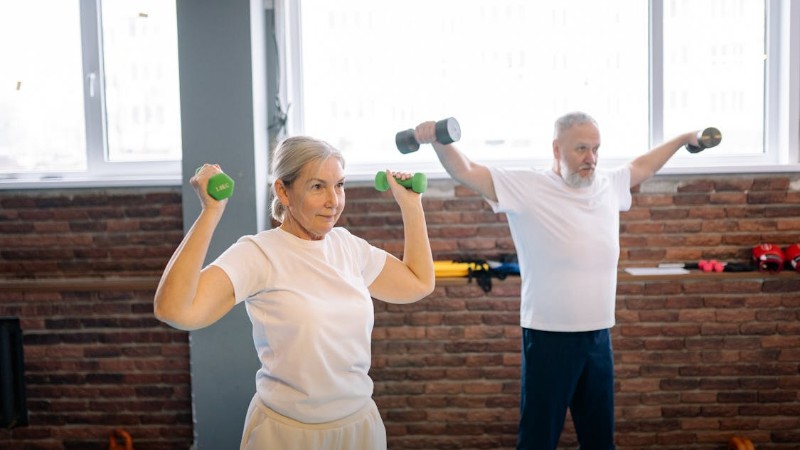In the United States, the concept of living a long, healthy life is often tied to individual habits and personal decisions. However, recent studies reveal that longevity is also deeply influenced by factors outside an individual’s control, such as education and socioeconomic status. With life expectancy diverging widely across demographic lines, understanding the causes behind these disparities has become crucial for improving public health.
While advancements in medicine and awareness of health practices have extended the average lifespan, the benefits have not been evenly distributed. Many Americans are left grappling with how their environment, access to resources, and daily choices shape their health outcomes.
Key Takeaways
In the US, longevity is influenced by individual habits, education, socioeconomic status, and geographic location, leading to significant disparities in life expectancy.
- Regular physical activity, such as brisk walking or cycling, can enhance longevity by reducing heart disease risk, boosting the immune system, and improving mental well-being.
- Higher education plays a crucial role in improving life expectancy by influencing behaviors, access to resources, and overall opportunities, with individuals who graduate college living 10.7 years longer than those without a high school diploma.
- Addressing systemic issues such as economic instability, limited healthcare access, and educational inequities is essential for narrowing the longevity gap and promoting well-being across diverse populations.
The life expectancy gap
Life expectancy in the U.S. has seen notable disparities between groups. These differences are often tied to education levels, income, and geographic location. Individuals with higher education tend to live significantly longer than those with less formal schooling.
Education plays a key role because it often correlates with healthier lifestyles, better job opportunities, and access to quality healthcare. Those with higher levels of education are more likely to avoid behaviors like smoking and are better equipped to adopt beneficial practices such as regular exercise and balanced diets.
Geographic factors compound these disparities. Rural areas, where healthcare facilities are scarce and preventative services are harder to access, often report lower life expectancies compared to urban centers. These patterns underline how systemic inequalities continue to affect communities differently across the country.
Life expectancy vs health expenditure in one graph.
The trillion dollar question: do you achieve better healthcare outcomes by spending more on healthcare?
It seems not really and the US system is the proof for that.
Even though a few good examples stand out. pic.twitter.com/vb6fVGGYlI
— Berci Meskó, MD, PhD (@Berci) January 13, 2025
Exercise and longevity
Regular physical activity is one of the simplest yet most effective ways to enhance longevity. Exercise supports cardiovascular health by strengthening the heart and improving blood flow, reducing the risk of heart disease, the leading cause of death in the United States. Furthermore, consistent movement bolsters the immune system, making it easier for the body to fight off infections and chronic conditions.
Research has also linked exercise to a lower likelihood of developing type 2 diabetes and certain cancers, illustrating its profound impact on long-term health outcomes. Incorporating exercise into daily routines does not have to involve intense workouts or hours at the gym. Simple activities like brisk walking, cycling, swimming, or even stretching can provide substantial health benefits when done consistently.
Experts from the Centers for Disease Control and Prevention recommend at least 150 minutes of moderate aerobic activity per week, which can be broken into manageable sessions. For those with busy schedules, short bursts of movement throughout the day, such as climbing stairs or taking active breaks, can still contribute to overall health and longevity. https://www.youtube.com/watch?v=13Y1euciWEs&ab_channel=LeeHealth.
The benefits of exercise extend beyond physical health, playing a crucial role in emotional and mental well-being. Workout routines reduce stress levels by lowering cortisol, a hormone associated with stress, and boosting endorphins, which promote feelings of happiness and relaxation. This can be especially important in combating depression and anxiety, which have become increasingly prevalent in the United States.
Additionally, exercise improves sleep quality, enabling the body to recover and rejuvenate, which further contributes to mental clarity and emotional stability. Physical activity also has significant cognitive benefits, particularly as people age. Studies have shown that exercise enhances brain function, improving memory, focus, and problem-solving skills.
It can even help slow cognitive decline and reduce the risk of developing neurodegenerative diseases such as Alzheimer’s. With these wide-ranging advantages, integrating regular movement into daily life becomes an essential strategy not only for extending lifespan but also for enriching the quality of life at every stage.
The role of socioeconomic status
Financial stability often determines whether individuals can access the resources necessary for a healthy life. Those living in poverty face barriers such as limited access to nutritious food, safe environments for exercise, and reliable healthcare services. For many, the cost of medical care alone deters routine checkups and early intervention, increasing the risk of undiagnosed and untreated illnesses.
Economic insecurity also adds stress, which negatively impacts both mental and physical health. Prolonged stress has been linked to high blood pressure, weakened immune systems, and other health complications that shorten life expectancy.
Efforts to bridge the economic divide are essential for improving the nation’s overall health. Expanding access to affordable healthcare, promoting education, and implementing community programs can significantly reduce the longevity gap.
Education’s far-reaching impact
Higher education plays a significant role in improving life expectancy by influencing behaviors, access to resources, and overall opportunities. According to Ali Mokdad, an epidemiologist at the Institute for Health Metrics and Evaluation (IHME) and an author of a related study, individuals with more education are more likely to seek out and adhere to medical advice, which helps them make better health decisions.
The study also revealed that education helps explain life expectancy differences among white individuals in low-income counties, where the average income is less than $32,363.
Dr. Laura Dwyer-Lindgren, IHME associate professor, has studied how educational attainment shapes health outcomes. Her research highlights that those who graduate college live, on average, 10.7 years longer than individuals who have not completed high school. This striking gap underscores the powerful influence of education on longevity. The disparity further highlights that education does more than prepare individuals for careers—it provides the tools necessary for informed and healthier living.
Health disparities in marginalized communities
Communities of color and other marginalized groups often experience significant health disparities in the U.S. These gaps are frequently tied to systemic inequalities, such as racial discrimination, limited access to healthcare, and economic challenges.
For example, Black Americans face higher rates of chronic conditions like hypertension and diabetes, which contribute to shorter lifespans compared to their white counterparts. Similarly, American Indians and Alaska Natives have been disproportionately affected, with life expectancy in some western regions dropping below 64 years—comparable to life expectancies in some of the world’s poorest nations.
Addressing these disparities requires systemic change, including investments in education, housing, and community health initiatives. Efforts should focus on improving healthcare accessibility in underserved areas, addressing socioeconomic inequalities, and creating culturally sensitive public health programs.
Steps toward change
While individual habits like regular exercise and healthy eating are crucial, addressing systemic issues is essential for meaningful progress. Policymakers, educators, and community leaders play a vital role in narrowing the longevity gap.
Promoting physical activity through public parks, community fitness programs, and safe walking trails can encourage healthier lifestyles. Similarly, expanding access to quality education and affordable healthcare can provide individuals with the tools they need to make informed health choices.
Public awareness campaigns also have the potential to inspire change. By highlighting the link between daily habits and long-term health, these initiatives can motivate individuals to prioritize their well-being.
A collective effort for better health
Improving life expectancy across all communities requires collaboration between local and national efforts. Community-driven initiatives can encourage healthier lifestyles by providing accessible fitness programs, safe spaces for physical activity, and affordable wellness resources. These localized efforts, combined with national strategies addressing systemic issues like education and economic disparities, offer opportunities to close health gaps and promote well-being across diverse populations.
Addressing the root causes of health disparities is key to creating lasting change. Economic instability, limited healthcare access, and educational inequities disproportionately affect underserved communities, contributing to shorter lifespans. Tackling these challenges through expanded access to quality education, affordable healthcare, and job opportunities can empower individuals to make informed decisions about their health and improve outcomes across the board.















